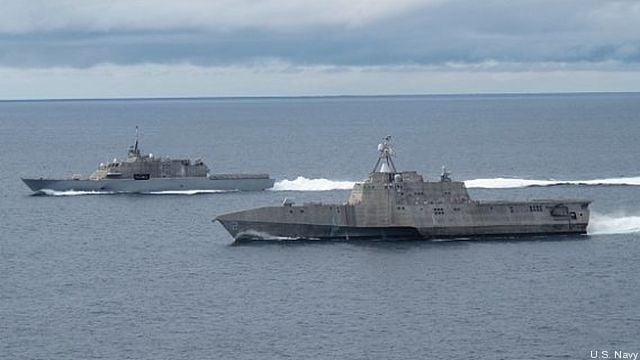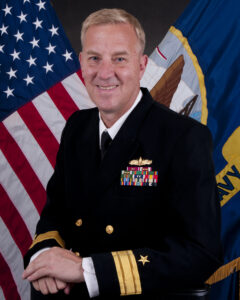LCS Veteran Takes Helm Of Troubled Program: RADM John Neagley
Posted on

The two variants of the Navy Littoral Combat Ship — LCS-1 Freedom and LCS-2 Independence – side by side off the California coast.
UPDATED with insider comment
WASHINGTON: Rear Adm. John Neagley helped write the requirements for the controversial Littoral Combat Ship some 13 years ago. Now Neagley, who’ll pin on his second star, is returning to LCS as Program Executive Officer at a particularly troubled time.

Rear Adm. John Neagley
LCS is still trying to right itself after one defense secretary overhauled the program in 2014 and the next secretary cut it by one quarter in 2015. Congressional batterings are constant. And at this moment, there’s also a 60-day Navy review underway of the ships’ performance so far. (See the group’s chartering memo below). Littoral Combat Ships have suffered high-profile breakdowns off both the East Coast and Singapore. Navy officials say mechanical teething troubles and reviews of lessons-learned are both routine for such a new class of vessel.
Neagley brings extensive experience in both the operational fleet and the LCS program to the job. After joining the Navy headquarters staff (OPNAV) in 2003, Neagley became lead requirements officer for LCS, overseeing the official performance objectives that drove the much-debated design: its jaw-dropping but gas-guzzling speed, its fast but fragile hull, and its light armament. In 2005, he moved over to the procurement side and became principal assistant program manager for LCS, focusing on the unglamorous but essential work of sustainment. It’s always challenging to get the spare parts, repair procedures, and other logistics in place for a new ship, but it’s particularly difficult for a small vessel with a small crew that critics say is overworked just keeping up with routine maintenance.
UPDATE BEGINS “John Neagley has a lot of experience with LCS,” one retired Navy officer told me. “While experience is generally a good thing, this also means he was involved in decisions that resulted in LCS having an incomplete capability analysis at the start, and, until the last couple of years, a poorly defined operational concept and unstable requirements.”
“Neagley’s collaborative leadership style will be useful in LCS, where there are a lot of entrenched opinions on either side of the program,” the officer continued. “He sees the value in the modular approach LCS exemplified” — with a basic “seaframe” accommodating different plug-and-play “modules” for minesweeping, sub-hunting, and surface combat — “but understands there may be ways it needs to be adjusted to ensure the basic sea frame has enough inherent capability to defend itself and have sufficient lethality against enemy targets. That modified approach to modularity will be incorporate into the frigate” — the upgunned future variant of LCS — “and the Navy’s future surface combatant.”
“On the whole, Admiral Neagley is likely to be able to combine his experience with today’s stability in the program to effectively manage LCS,” said the officer — but that hard-won stability is at risk with the planned transition to the frigate and the Navy’s desire to backfit some of the frigate’s improvements into the existing LCS designs. UPDATE ENDS
In his seafaring life, Neagley is unusual in having served aboard every size of surface ship: from a 4,000-ton-displacement Perry-class frigate, now retired and being replaced by LCS; to a 9,000-ton Arleigh Burke destroyer, a 9,600-ton Ticonderoga cruiser, a 45,000-ton Midway carrier (since retired), and a 100,000-ton Nimitz-cass aircraft carrier. He also headed the fielding of radio jammers and bomb squad equipment to counter roadside bombs (Improvised Explosive Devices) in Afghanistan and Iraq from 2009 to 2011. In his current assignment, he is deputy commander for readiness at Space and Naval War Systems Command (SPAWAR). As PEO-LCS, he’ll replace Rear Adm. Brian Antonio.
Subscribe to our newsletter
Promotions, new products and sales. Directly to your inbox.
